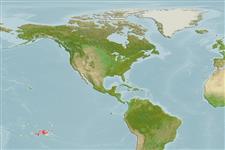Classification / Names
Noms communs | Synonymes | Catalog of Fishes(Genre, Espèce) | ITIS | CoL | WoRMS | Cloffa
>
Pleuronectiformes (Flatfishes) >
Soleidae (Soles)
Etymology: Aseraggodes: Greek, aggos, -eos, -ous = vessel, uterus, carapace of a crab + Greek, aseros, -a, -on = to remove the appetite (Ref. 45335); auroculus: Name from the Latin 'aurum' for gold and 'oculus' for eye, referring to the bright golden color of the eyes..
More on author: Randall.
Environment: milieu / climate zone / depth range / distribution range
Écologie
marin récifal; profondeur 15 - 24 m (Ref. 57560). Tropical
Eastern Central Pacific: Society Islands.
Taille / Poids / Âge
Maturity: Lm ? range ? - ? cm
Max length : 3.6 cm SL mâle / non sexé; (Ref. 57560)
Description synthétique
Morphologie | Morphométrie
Rayons mous dorsaux (Total): 74-77; Rayons mous anaux: 56 - 57; Vertèbres: 37 - 38. Diagnosis: Dorsal rays 74-77; anal rays 56-57; most dorsal and anal rays double branched. Lateral-line scales 69-73. including 6-7 anterior to a vertical at upper end of gill opening. Vertebrae 37-38; dorsal pterygiophores anterior to fourth neural spine 12. Body depth 2.45-2.6 in SL; head length (HL) 3.85-3.95 in SL; eye diameter 4.55-4.9 in HL; upper eye overlapping a anterior two-thirds to three-fourths of lower eye; interorbital space narrow, the vertical distance between eyes about one-fourth to one-sixth eye diameter. Caudal peduncle absent. Short fleshy cirri on ventral edge of head. Lateral line aligned with ventral part of upper eye. Longest dorsal ray 1.55-1.7 in HL; caudal fin rounded, 4.4-4.55 in SL in length; pelvic fins 2.4-2.7 in HL, the tip of longest ray reaching base of second or third anal ray. Body color of ocular side in alcohol pale yellowish brown with 3 rows of large irregular blackish blotches, one dorsal, one ventral, and one midlateral; a few small dark spots on fin rays; blind side pale yellowish, the dark spots on rays faint (Ref. 57560).
Collected from steep sloping bottoms dominated by coral rubble (Ref. 57560).
Life cycle and mating behavior
Maturité | Reproduction | Frai | Œufs | Fécondité | Larves
Randall, J.E., 2005. A review of soles of the genus Aseraggodes from the South Pacific, with descriptions of seven new species and a diagnosis of Synclidopus. Memoirs of Museum Victoria 62(2):191-212. (Ref. 57560)
Statut dans la liste rouge de l'IUCN (Ref. 130435)
Menace pour l'homme
Harmless
Utilisations par l'homme
Plus d'informations
PaysZones FAOÉcosystèmesOccurrencesIntroductionsStocksÉcologieRégime alimentaireÉléments du régime alimentaireConsommation alimentaireRation
Noms communsSynonymesMétabolismePrédateursÉcotoxicologieReproductionMaturitéFraiRassemblement de ponteFéconditéŒufsDéveloppement de l'œuf
Taille/ÂgeCroissanceLongueur-poidsLongueur-longueurFréquences de longueursMorphométrieMorphologieLarvesDynamique des populations larvairesRecrutementAbondanceBRUVS
RéférencesAquacultureProfil d'aquacultureSouchesGénétiqueElectrophoresesHéritabilitéPathologiesTraitementNutrientsMass conversion
CollaborateursImagesStamps, Coins Misc.SonsCiguateraVitesseType de nageSurface branchialeOtolithesCerveauxVision
Outils
Articles particuliers
Télécharger en XML
Sources Internet
Estimates based on models
Preferred temperature (Ref.
123201): 26.9 - 29, mean 27.8 °C (based on 99 cells).
Phylogenetic diversity index (Ref.
82804): PD
50 = 0.5000 [Uniqueness, from 0.5 = low to 2.0 = high].
Bayesian length-weight: a=0.00977 (0.00473 - 0.02021), b=3.07 (2.90 - 3.24), in cm total length, based on LWR estimates for this (Sub)family-body shape (Ref.
93245).
Niveau trophique (Ref.
69278): 3.2 ±0.5 se; based on size and trophs of closest relatives
Résilience (Ref.
120179): Haut, temps minimum de doublement de population inférieur à 15 mois (Preliminary K or Fecundity.).
Fishing Vulnerability (Ref.
59153): Low vulnerability (10 of 100).
